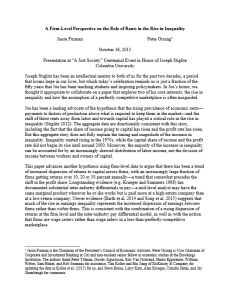Join getAbstract to access the summary!

Join getAbstract to access the summary!
Peter Orszag
A Firm-Level Perspective on the Role of Rents in the Rise in Inequality
US Government, 2015
What's inside?
To understand why income inequality is growing, look to home prices and workers’ mobility.
Recommendation
Inequality is a hot topic among practitioners of the dismal science, but this report from two noted economists sheds new light on the oft-probed issue. Jason Furman and Peter Orszag delve into new corners of the income-inequality picture, noting that returns to housing-related capital have outpaced returns to other types of capital. In another insight, they find that American workers no longer move around the country as they once did, a shift with implications for economic mobility. Alas, their text is replete with economics jargon. Nonetheless, getAbstract recommends this innovative study to investors and policy makers seeking fresh ideas on the problem of income inequality.
Summary
About the Author
Jason Furman is chairman of the President’s Council of Economic Advisers. Peter Orszag is vice chairman of corporate and investment banking at Citigroup.


















Comment on this summary